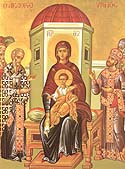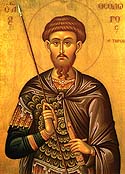Lenten Services
The weekday services of Great Lent are characterized by special lenten melodies of a penitential character. The royal gates to the altar area remain closed to signify man’s separation through sin from the Kingdom of God. The church vesting is of a somber color, usually purple. The daily troparia are also of an intercessory character, entreating God through his saints to have mercy on us sinners.
At the Matins the long Alleluia replaces the psalm: God is the Lord . . . the Psalmody is increased. The hymnology refers to the lenten effort. Scripture readings from Genesis and Proverbs are added to Vespers, and the Prophecy of Isaiah to the Sixth Hour. Each of these books is read nearly in its entirety during the lenten period. Epistle and gospel readings are absent because there are no Divine Liturgies.
At all of the lenten services the Prayer of Saint Ephraim of Syria is read. It supplicates God for those virtues especially necessary to the Christian life.
O Lord and Master of my life: take from me the spirit of sloth, faint-heartedness, lust of power and idle talk.
But grant rather the spirit of chastity, humility, patience and love to Thy servant.
Yea, O Lord and King, grant me to see my own errors and not to judge my brother, for blessed art Thou unto ages of ages. Amen.
The Vespers service which begins the lenten season is called the Vespers of Forgiveness. It is customary at this service for the faithful to ask forgiveness and to forgive each other. At the Compline services of the first week of lent the Canon of Saint Andrew of Crete is read. This is a long series of penitential verses based on Biblical themes, to each of which the people respond: Have mercy on me, O God, have mercy on me. This canon is repeated at Matins on Thursday of the fifth week.

On Friday evening of this same fifth week, the Akathistos Hymn to the Mother of God is sung; and the Saturday Divine Liturgy also honors the Theotokos.

The first Saturday of Great Lent is dedicated to the memory of Saint Theodore of Tyre. The second, third, and fourth Saturdays are called Memorial Saturdays since they are dedicated to the remembrance of the dead.
On Memorial Saturdays the liturgical hymns pray universally for all of the departed, and the Matins for the dead, popularly called the parastasis or panikhida, is served with specific mention of the deceased by name. Litanies and prayers are also added to the Divine Liturgy at which the scripture readings refer to the dead and their salvation by Christ.
Saturday, even during the non-lenten season, is the Church’s day for remembering the dead. This is so because Saturday, the Sabbath Day, stands as the day which God blessed for life in this world. Because of sin, however, this day now symbolizes all of earthly life as naturally fulfilled in death. Even Christ the Lord lay dead on the Sabbath Day, “resting from all of his works” and “trampling down death by death.” Thus, in the New Testament Church of Christ, Saturday becomes the proper day for remembering the dead and for offering prayers for their eternal salvation.
